The title of the project that Ilona Gaynor presented at the Idea in Progress show at the RCA, London a few weeks ago could be applied to almost every single story that graces newspaper front pages nowadays. I’ve actually stopped counting the times the word ‘chaos’ has been used in connection with unrest in the Middle East and North Africa. What surprises me is how often the news of ongoing ‘chaos’ in Libya or Egypt is associated with ‘Western’ fears of a rise of oil prices or spike in immigration numbers.
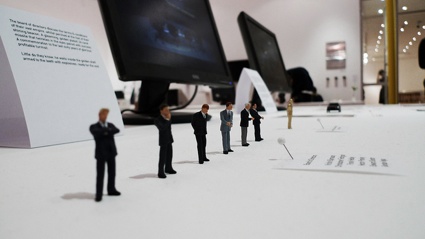 Image Ilona Gaynor
Image Ilona Gaynor
Everything Ends in Chaos fascinated me because it is somehow related to all of the above and much more. The project attempts to design, then reverse engineer a single, spectacular Black Swan event. Black Swan events are unpredicted but of such magnitude that they have an important impact on history. Nassim Nicholas Taleb exposed this theory in 2007, in a book that has been credited with predicting the banking and economic crisis of 2008. According to Taleb, the rise of the Internet, World War I, and the September 11 attacks as examples of Black Swan Events.
Ilona’s research topic is ambitious, it spans economics, finance, global markets, risk management, insurance and mathematics. I aim to explore the paradoxical nature of policy by examining and speculating on the ‘invisible’ negotiations and momentary instances that affect, compromise and twist policy for means of financial and / or political gain as well as its implications.
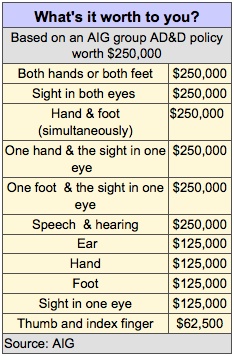 What are your body parts worth? By Insure.com, Dec. 7, 2009
What are your body parts worth? By Insure.com, Dec. 7, 2009
For the work in progress show at the RCA, Ilona presented two fictional scenarios that intertwine real documents revealing actual insurance practices (such as the existence of kidnap and ransom insurance, of dismemberment insurance and charts listing the worth of your body parts, etc.) with imaginary stories. The result is an exploration of the seemingly fictional paradoxes that could occur and unfold as a result of precautionary bureaucratic policies.
Follow the project on twitter!
Could you take us through the scenarios? In the first one a bomb is hidden inside golden trophy hangs above the heads of directors in a boardroom. In the second scenario, the wife of a rich insurance broker is kidnapped. What lies behind those snapshots of the whole story? How are both scenarios related to one another?
Ilona Gaynor: The first scenario takes place within a boardroom at an underwriters firm called A-Corporation, the firm specialises in the insurance of military assets, from missiles to the transportation of assets between geographical borders. The 24 carat golden missile that hangs so delicately above their head’s, was commissioned and hung by the CEO of A-Corporation as a commemoration, a beacon of hope, and inspiration, a celebration for the last profitable decade of underwritten contracts. There are 6 board members that sit within this room, all of whom are exceptionally well paid and each have a severance contract attached to their position within the company. A-Corporation is considering a merger and through its decision decides to blow up the boardroom, with the intention of killing its 6 board members, and therefore rendering the severance agreements null in void.
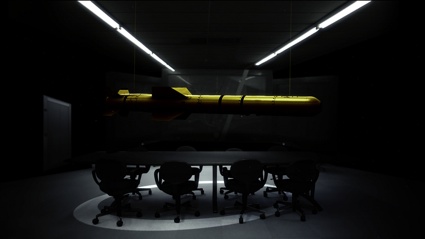 A-Corporations Board Room (scenario film still). Image Ilona Gaynor
A-Corporations Board Room (scenario film still). Image Ilona Gaynor
The second scenario takes place around a family called the Henderson’s. Mrs Daphne Henderson is the wife of Frank Henderson, a wealthy senator. Mrs Henderson is kidnapped. She was taken from their family Mercedes state car on a highway in Arizona, which the kidnappers mistook for the Senators motorcade vehicle. The kidnappers cut off her wedding ring finger and sent it via FedEx to the Henderson’s family Insurance broker Mr Bowery of Hiscox, along with their ransom demands. Upon receiving her finger, the broker was ordered by the senator for the ransom money to be sent immediately. In the expecting return of Mrs Henderson, the senator decided to throw a small party to welcome her back to their home. Not knowing how hideously disfigured she might be, he took the liberty of inviting their plastic surgeon.
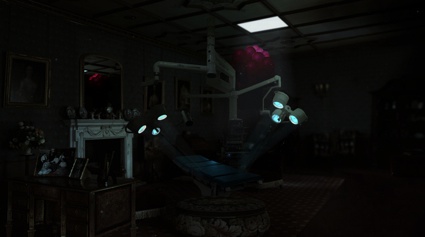 Welcome home party at Henderson Manor (scenario film still). Image Ilona Gaynor
Welcome home party at Henderson Manor (scenario film still). Image Ilona Gaynor
In the exhibition the two video scenarios were accompanied by various artefacts relating to each of the stories. The artefacts are made up of designed and doctored legal contracts, mostly insurance related to pull the fiction back into the reality. The contracts, fine prints and stock snapshots are offered up to the audience as evidence, physical coordinates that lead to and highlight the very real motives involved and reveal the benefactors. The scenarios will eventually relate to each other in a larger narrative, made up of a series, 5 events to be exact.
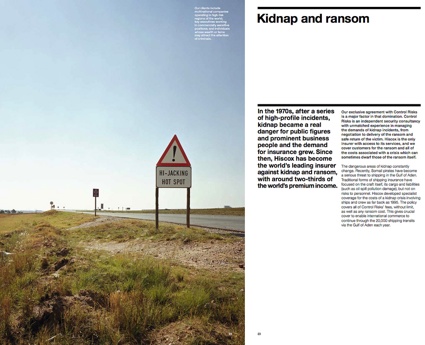 Pages from The Hiscox Corporate Brochure 2009. Image Ilona Gaynor
Pages from The Hiscox Corporate Brochure 2009. Image Ilona Gaynor
Your scenarios are fictional but how do they relate exactly to the current economic situation? Do they have relevance on a global level or do they mostly apply to the UK situation?
Ilona Gaynor: Over the last 3 years, we have all been confronted by a global economic crisis. It seems to be all too easy to critically attack and lay blame to bankers, market traders and corporations.
I think it’s more important if not more interesting to contextualise and frame the infrastructure that was able to facilitate such media projected ‘atrocities’ and make sense of something that has such impact on our lives and our future. The scenarios are hypothetical, an exaggerated microscopic look at a system that exists within our proximity, that often goes fairly un-noticed, or is deemed too complex to be understood. My research for this project has led to such potent content; that moving beyond the ‘highlighting illustrative’ and pushing it into the designed hypothetical is really important. We can all relate to insurance and the frustrating paradoxes that crop up within mundane bureaucracy, but we might not all be aware of the circumstances that need to occur in order for the various systems in play to spit out a sizeable profit.
EEIC deals with economic policy. What could be the role of a designer in the context of economics?
Ilona Gaynor: I think the role of designers in economics is crucial and could be one of reflection and scenario based strategy. It is becoming more evident that the role of human behaviour in systems design, particularly those designed to monopolize tends to be neglected. Human nature makes mistakes, not the machines. How could we possibly manage risk without the acknowledgment of this key factor? Design has the power to stimulate the imagination and make abstract issues tangible. If we can use speculative design proposals to imagine alternative trajectories and reflect upon current methodologies, it might allow us to open up a meaningful debate before policies are written. Designers have been starting to contribute to many important fields for years, from medicine to politics. I don’t see why economics should be any different.
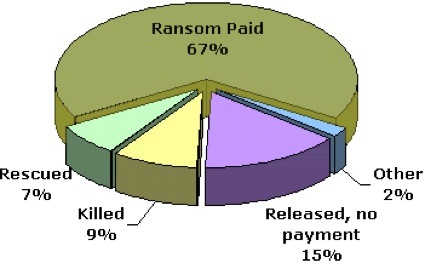 Coverage Kidnap, Ransom and Detention Insurance has secretly existed for many years. Petersen have determined that the public needs to know about this valuable coverage. International Kidnap/Detention and Crisis Assistance Coverage provides easy access and implementation
Coverage Kidnap, Ransom and Detention Insurance has secretly existed for many years. Petersen have determined that the public needs to know about this valuable coverage. International Kidnap/Detention and Crisis Assistance Coverage provides easy access and implementation
The project looks very cynical to me. The title itself is fairly daunting. What is the critical discourse behind the project? Do you really have such a dark view of economics?
Ilona Gaynor: I have a dark view of most things, but unlike most I don’t think it’s a bad thing… the world makes more sense in the dark… it’s when it’s viewed in the light that we should be worried. Economics, I don’t think is necessarily so sinister… the Vatican for example is probably more riddled with corruption, scandal and greed then the banking sector. But I do think that as its complexity continues to grow and get increasingly denser, it starts to tangle and knots occur. It’s becoming more and more difficult to control such a living organism and I don’t think we can continue down a pathway that’s so obviously treacherous. The critical discourse lies in my aim to celebrate such a system. It’s a non-human entity with non-human goals, and it’s deliciously destructive. It was designed for one thing only – to make a profit. The seduction is obvious, you only have to witness Oliver Stone’s Gordon Gekko to empathise with such a honey trap.
We can do one of two things: we can witness it unravel and enjoy the complicated pleasure accepting that “greed is good“, or we can move towards a rethink of how we design economic and financial systems.
EEIC is still a work in progress. How much research do you still have to do? And where do you think that it will lead you to?
Ilona Gaynor: The research will always be ongoing, I think it’s important that the dialogue between the economics and finance communities and myself continues to be ongoing and stays strong.
But my quest overall, is to design and then communicatively reverse engineer a singular ‘Black Swan‘ event. The work in progress (for the show in particular) was more of an exercise in communicating such complex abstract narratives viscerally. I intend to write a further three scenarios, drawing on the emphasis of which is to highlight the principal of cause and affect. The final project will take the form of films (five in total). The stories will highlight linchpin key moments that will merge to become a hypothetical Black Swan event.
A second layer to the project will then be an assessment made by five legitimate insurance underwriters. This will be carried out to determine how much actual profit (written in insurance premiums and contracts) in monetary terms is extractable from my hypothetical scenarios. Can we really insure for the highly unexpected? How much money is a chaotic collapse actually worth? Who might be the winner? And Is this something to aspire to?
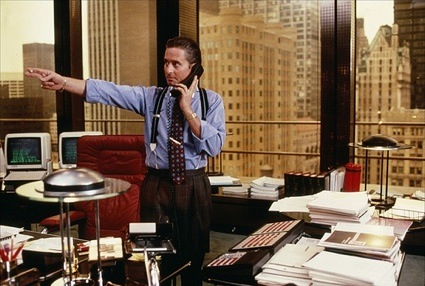 Gordon Gekko. Still from the movie Wall Street
Gordon Gekko. Still from the movie Wall Street
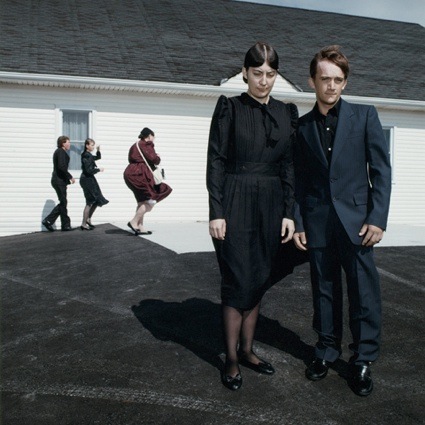 Morad Bouchakour, Ontario Canada, from the series Mexican Mennonites
Morad Bouchakour, Ontario Canada, from the series Mexican Mennonites
I saw on your flickr set that you did some research to create a precise aesthetics for the project. What kind of feeling and ideas does this aesthetics try to convey?
Ilona Gaynor: The aesthetics need to be precise enough to pull you into a world. I’m interested in drawing upon the hyper-real, something that could be deemed uncanny, to reflect the hypothetical absurd nature of the world we are looking down upon. I want the audience to experience something voyeuristic, as if you were that third person in the scene, totally absent from participation but free to stand, observe and smirk… ‘There’s an elephant in the room and no one can see it but me’.
To give a sense of place, to me is thrilling. Places are made up of a very fluent language of detail and are therefore incredibly important and necessary in allowing you to dream and speculate beyond four walls. Taking into account color, perspectives, shape and texture… if all those things are correct and something catches your eye in certain way, with a certain kind of light and the right subtle movement you’re gone, you’re in heaven. I think the world I’m playing in is so distinctly un-explored, you can’t go in and film it, unless you first build it first.
Thank you Ilona!
Other project from Design Interactions’ latest work in progress show: Known Unknowns and BACK, HERE BELOW, FORMIDABLE [ the rebirth of prehistoric creatures ].
Credit image on the homepage: Dunne and Raby.
